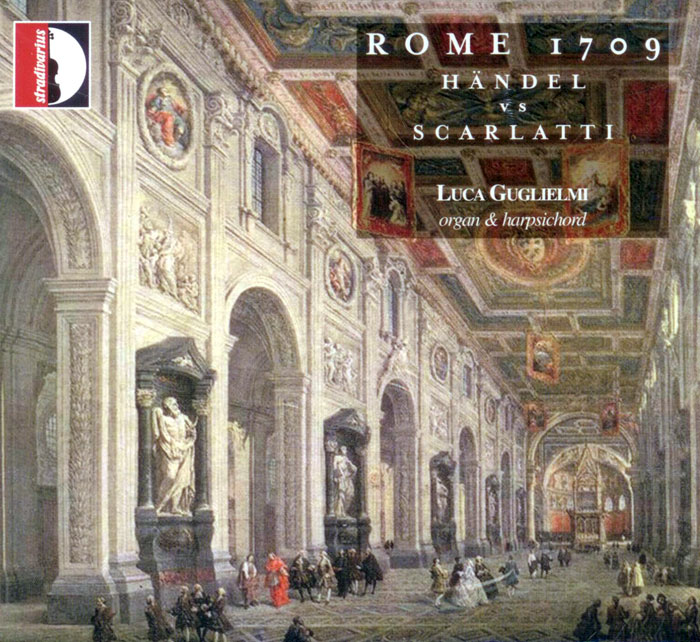Logowanie
Mikołaj - ten to ma gest!
Elton John, The Mamas & The Papas, Cat Stevens, Rod Stewart, Bobbie Gentry, Stevie Wonder, Engelbert Humperdinck
Memory Lane
Edycja Numerowana - 1000 egzemplarzy w skali światowej
RACHMANINOV, Eiji Oue, Minnesota Orchestra
Symphonic Dances / Vocalise
Best Recordings of 2001!!! NAJCZĘŚCIEJ KUPOWANA PŁYTA Z RR!
Karnawał czas zacząć!
Music of Love - Hi-Fi Latin Rhythms
Samba : Music of Celebration
AUDIOPHILE 24BIT RECORDING AND MASTERING
CHOPIN, LISZT, DEBUSSY, DVORAK, Gerhard Oppitz
Dances romantiques - A fantastic Notturno
Wzorcowa jakość audiofilska z Clearaudio
Winylowy niezbędnik
ClearAudio
Double Matrix Professional - Sonic
najbardziej inteligentna i skuteczna pralka do płyt winylowych wszelkiego typu - całkowicie automatyczna
HANDEL, SCARLATTI, Luca Guglielmi
Handel vs Scarlatti Rome 1709.
- Various Artists - Rome 1709: Händel vs Scarlatti
- 01. Handel, George Frideric (1685-1759) - Preludio HWV 564 (1:53)
- 02. Handel, George Frideric (1685-1759) - Toccata HWV 586 (2:07)
- 03. Handel, George Frideric (1685-1759) - Sonata in G minor HWV 590: larghetto (2:02)
- 04. Handel, George Frideric (1685-1759) - Sonatina in G minor HWV 583: a tempo giusto (2:20)
- 05. Handel, George Frideric (1685-1759) - Preludio & Allegro HWV 576 (3:13)
- 06. Handel - Allemande HWV 478 (3:23)
- 07. Scarlatti - Sonata K 87 (5:31)
- 08. Handel - Allegro HWV 475 (1:43)
- 09. Scarlatti - Gavotta K 64 (1:50)
- 10. Handel - Partita in C minor HWV 444/445: prelude (1:06)
- 11. Handel, George Frideric (1685-1759) - Partita in C minor HWV 444/445: allemande (4:21)
- 12. Handel, George Frideric (1685-1759) - Partita in C minor HWV 444/445: courante (2:10)
- 13. Handel, George Frideric (1685-1759) - Partita in C minor HWV 444/445: gavotte (0:53)
- 14. Handel, George Frideric (1685-1759) - Partita in C minor HWV 444/445: menuet (1:32)
- 15. Scarlatti, Domenico (1685-1757) - Allegro K 85 (1:54)
- 16. Scarlatti, Domenico (1685-1757) - Allegro (Fuga) K 82 (2:59)
- 17. Scarlatti, Domenico (1685-1757) - Giga K 78 (1:28)
- 18. Scarlatti, Domenico (1685-1757) - Minuetto K deest (1:29)
- 19. Handel, George Frideric (1685-1759) - Fuga HWV 611 (2:46)
- 20. Scarlatti, Domenico (1685-1757) - Fuga K 41 (4:21)
- 21. Scarlatti, Domenico (1685-1757) - Capriccio: Allegro K 63 (2:17)
- 22. Handel, George Frideric (1685-1759) - Prelude HWV 571 (1:36)
- 23. Handel, George Frideric (1685-1759) - Capriccio HWV 571 (2:53)
- 24. Scarlatti, Domenico (1685-1757) - Sonata in D minor K 34: Larghetto (2:31)
- 25. Handel, George Frideric (1685-1759) - Sonatina HWV 581 (1:39)
- 26. Scarlatti, Domenico (1685-1757) - Sonata K 61 (3:14)
- 27. Handel, George Frideric (1685-1759) - Chaconne HWV 485 (4:52)
- Luca Guglielmi - organ
- HANDEL
- SCARLATTI
The only evidence for Handel’s infamous encounters with his exact contemporary Domenico Scarlatti are their brief descriptions in Mainwaring’s Memoirs of the Life of the Late George Frederic Handel. The anecdote relates that Handel and Scarlatti entered a musical contest with each other at the palace of Cardinal Ottoboni, and that, although the common consensus was that they shared the palms on the harpsichord, Scarlatti generously acknowledged the Saxon’s superiority on the organ. Yet it was also Handel’s mastery of the organ that brought him attention in Rome: a contemporary diarist wrote on 14 January 1707 that “There is lately arrived in this city a Saxon who is a most excellent player upon the harpsichord and composer of music and who today made great pomp of his virtue in playing upon the organ in the church of San Giovanni to the amazement of all.” It is unknown what music Handel would have performed on either of those two historic occasions. No body of organ music by Handel – apart from the concertos composed later in England - survives in a recognizable form. Furthermore, the harpsichord contest is likely to have been a battle of wits by two brilliant keyboard players extemporizing on the spot. We shall never know exactly what happened or what was played, so Luca Guglielmi has therefore assembled a sensible reconstruction of both events using suitable examples of the work of each composer. The resulting solo recital disc may be the closest we shall ever come to imagining these two colourful episodes from the youthful Handel’s time in Italy. It is a mild pity that there is not a great sense of competition in the contest between Handel and Scarlatti that constitutes the torso of the disc. Although the instruments and performances are excellent, perhaps two separate harpsichords, and, indeed, two separate harpsichordists, might have made the project seem more lifelike and dramatically engaging. Yet Guglielmi really scores points in his suggestion for ‘Handel’s recital’ at the church of San Giovanni in Laterano: it is actually recorded in that church, using the same instrument that Handel would have played on 14 January 1707, although it has undergone several restorations since (bravo to the record label for including such thorough documentation about both this and the other instruments used on the recording). The magnificent organ had originally attracted Handel because it was reputed to be the largest in Rome, and it still makes quite a bit of noise today. It somehow seems odd that none of Handel’s opera houses still stand, yet both this Roman organ and the smaller instrument at the Duke of Chandos’s church still exist and are playable in something resembling their allegedly original states. Any Handel lovers that might wish to have been a fly on the wall at either of the events that inspired this disc ought to be at least moderately enchanted by Guglielmi’s recital. His may be an unfamiliar name to most, yet his performances are consistent and assured. Although this disc is of admittedly obscure repertoire, in some ways it arouses more curiosity and musicological satisfaction than looser concepts such as Andrew Parrott’s ‘Carmelite Vespers’ and Robert King’s 'The Coronation of George II'.





























